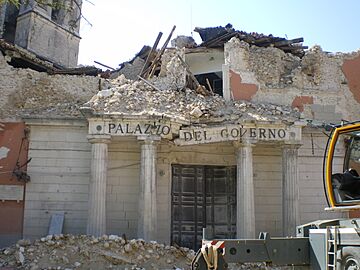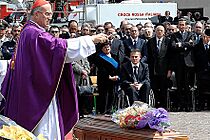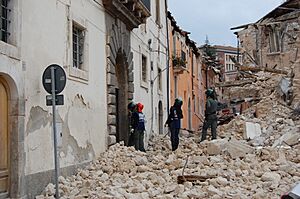2009 L'Aquila earthquake facts for kids

The local prefecture (a government office) damaged by the earthquake
|
|
| UTC time | 2009-04-06 01:32:42 |
|---|---|
| ISC event | 13438018 |
| USGS-ANSS | ComCat |
| Local date | 6 April 2009 |
| Local time | 03:32 CEST |
| Magnitude | Mw 6.3 (GCMT) |
| Depth | 9.46 km (5.88 mi) |
| Epicenter | 42°20′51″N 13°22′48″E / 42.3476°N 13.3800°E |
| Areas affected | Abruzzo, Italy |
| Total damage | $16 billion |
| Max. intensity | X (Extreme) |
| Peak acceleration | 0.66 g |
| Peak velocity | 42.83 cm/s |
| Casualties | 308 dead 1,500+ injured 66,000+ homeless |
On April 6, 2009, a strong earthquake hit the Abruzzo region in central Italy. It happened at 3:32 AM local time. The earthquake was measured at 6.3 on the moment magnitude scale. Its center, called the epicentre, was close to L'Aquila. This city is the capital of Abruzzo. L'Aquila and nearby villages were hit the hardest.
Before the main earthquake, there were many smaller quakes. These are called foreshocks. They started in December 2008. After the main quake, there were also many aftershocks. More than thirty of these were stronger than magnitude 3.5.
The earthquake was felt across central Italy. Sadly, 308 people died. This made it the deadliest earthquake in Italy since 1980. Many buildings were damaged or destroyed. About 66,000 people lost their homes. In 2022, 72% of the damaged areas in L'Aquila had been rebuilt.
Contents
Why Did the Earthquake Happen?
This earthquake happened because of how the Earth's plates move. Italy is in a complex area where large pieces of the Earth's crust, called tectonic plates, are constantly shifting. In central Italy, these plates are pulling apart. This pulling motion causes faults (cracks in the Earth's crust) to move.
The earthquake occurred on a specific type of fault. This fault is called a normal fault. It runs from the northwest to the southeast. The earthquake happened about 9.46 kilometers (about 6 miles) deep. Its center was near L'Aquila, about 90 kilometers (about 56 miles) northeast of Rome.
L'Aquila's Earthquake History
L'Aquila has a long history with earthquakes. The city was built on an old lakebed. This type of soil structure can make earthquake shaking feel stronger.
The city has been hit by many earthquakes over the centuries. Some notable ones include quakes in 1315, 1349, 1452, 1501, 1646, 1703, 1706, and 1958. The earthquake in February 1703 caused a lot of damage. It destroyed much of L'Aquila and killed about 5,000 people. Another major quake in 1915, near Avezzano, killed over 30,000 people. It happened only about 35 kilometers (22 miles) from L'Aquila.
What Were the Effects of the Earthquake?
The earthquake caused a lot of damage in L'Aquila. Between 3,000 and 11,000 buildings were damaged. Many buildings, especially older ones, completely fell down.
| Nationality | Deaths | Injured |
|---|---|---|
| 288 | 1,173 | |
| 5 | ||
| 5 | ||
| 2 | ||
| 2 | ||
| 1 | 5 | |
| 1 | ||
| 1 | ||
| 1 | ||
| 1 | ||
| 1 | ||
| Total | 308 | about 1,500 |
A total of 308 people died. This included people from Italy and other countries. About 1,500 people were injured. Twenty of the people who died were children. Around 66,000 people lost their homes.
The earthquake was felt far away, even in Rome, which is about 92 kilometers (57 miles) away. Schools in the Abruzzo region were closed. Many people left L'Aquila. Streets in the city center and nearby villages like Paganica were blocked by fallen debris. L'Aquila's hospital was damaged by an aftershock an hour after the main quake. Strong aftershocks continued for two days.
Some villages were hit very hard. Onna was almost completely destroyed. 38 people died there out of 350 residents. Villages like Villa Sant'Angelo and Borgo di Castelnuovo were also badly damaged.
Many historic buildings in L'Aquila were damaged. The Basilica of Saint Bernardino of Siena was seriously hurt. The dome of the church of Anime Sante in Piazza Duomo fell down. The 13th-century Basilica di Santa Maria di Collemaggio also collapsed. Even the new wing of L'Aquila Hospital, built in 2000 to be "earthquake-proof," was badly damaged and had to close.
Temporary Homes for Those Affected
About 40,000 people who lost their homes stayed in tent camps. Another 10,000 stayed in hotels along the coast. Others found shelter with friends and family.
The Prime Minister at the time, Silvio Berlusconi, made a comment that caused some debate. He said that homeless victims should think of it as a "camping weekend." He added that they had everything they needed, like medical care and hot food. He also told people to "Head to the beach. It's Easter. Take a break. We're paying for it."
Building Safety Rules
Many people believe that poor building standards or materials made the damage worse. Firefighters said that some concrete in fallen buildings seemed to be made poorly, maybe with too much sand. An official from Italy's Civil Protection Agency said that an earthquake like this in California would not have killed anyone. This suggests that stronger building rules could have saved lives.
Strange Lights in the Sky
Many people reported seeing strange lights during the earthquake. These included glows, flashes, and fireballs. Scientists call these earthquake lights. Over 240 reports of these lights were collected. Many of them happened before the main earthquake. Some scientists have even suggested using video cameras to detect these lights as a possible early warning system for earthquakes.
Aftershocks and Their Impact
After the main earthquake, many smaller earthquakes, called aftershocks, continued to shake the area. The strongest one, on April 7, measured 5.3 magnitude. It caused even more damage. Experts said that the aftershocks were moving away from populated areas, which was good news.
These aftershocks made it dangerous for rescue teams. They were searching for people in damaged buildings. Any aftershock could cause more walls to fall. The constant shaking also caused stress for children and older people. Because of this, the Italian government moved thousands of people away from the earthquake zone.
For example, the dome of the Anime Sante Basilica, which was already damaged, almost completely collapsed due to aftershocks. Other buildings in L'Aquila and nearby towns also fell. One strong aftershock was felt in Rome. It caused an elderly man to have a heart attack and die.
Major Foreshocks and Aftershocks
Here are some of the stronger foreshocks and aftershocks that happened:
| Date (YYYY-MM-DD) and time (UTC) |
Time (local) |
Lat. | Long. | Depth | ML |
|---|---|---|---|---|---|
| 2009-03-30 13:38:39 | 15:38:39 | 42.321° N | 13.376° E | 9.8 km (6.1 mi) | 4.1 |
| 2009-04-06 01:32:39 | 03:32:39 | 42.334° N | 13.334° E | 8.8 km (5.5 mi) | 6.3 |
| 2009-04-06 01:36:29 | 03:36:29 | 42.355° N | 13.342° E | 9.7 km (6.0 mi) | 4.7 |
| 2009-04-06 01:40:51 | 03:40:51 | 42.418° N | 13.408° E | 11.0 km (6.8 mi) | 4.1 |
| 2009-04-06 01:41:33 | 03:41:33 | 42.387° N | 13.316° E | 9.1 km (5.7 mi) | 4.3 |
| 2009-04-06 01:42:50 | 03:42:50 | 42.300° N | 13.429° E | 10.5 km (6.5 mi) | 4.2 |
| 2009-04-06 02:37:04 | 04:37:04 | 42.366° N | 13.340° E | 10.1 km (6.3 mi) | 4.6 |
| 2009-04-06 16:38:09 | 18:38:09 | 42.362° N | 13.333° E | 10.2 km (6.3 mi) | 4.0 |
| 2009-04-06 23:15:37 | 01:15:37 | 42.451° N | 13.364° E | 8.6 km (5.3 mi) | 4.8 |
| 2009-04-07 09:26:28 | 11:26:28 | 42.342° N | 13.388° E | 10.2 km (6.3 mi) | 4.7 |
| 2009-04-07 17:47:37 | 19:47:37 | 42.275° N | 13.464° E | 15.1 km (9.4 mi) | 5.3 |
| 2009-04-07 21:34:29 | 23:34:29 | 42.380° N | 13.376° E | 7.4 km (4.6 mi) | 4.2 |
| 2009-04-08 22:56:50 | 00:56:50 | 42.507° N | 13.364° E | 10.2 km (6.3 mi) | 4.3 |
| 2009-04-09 00:52:59 | 02:52:59 | 42.484° N | 13.343° E | 15.4 km (9.6 mi) | 5.1 |
| 2009-04-09 03:14:52 | 05:14:52 | 42.338° N | 13.437° E | 18.0 km (11.2 mi) | 4.2 |
| 2009-04-09 04:32:44 | 06:32:44 | 42.445° N | 13.420° E | 8.1 km (5.0 mi) | 4.0 |
| 2009-04-09 19:38:16 | 21:38:16 | 42.501° N | 13.356° E | 17.2 km (10.7 mi) | 4.9 |
| 2009-04-13 21:14:24 | 23:14:24 | 42.504° N | 13.363° E | 7.5 km (4.7 mi) | 4.9 |
| 2009-04-14 20:17:27 | 22:17:27 | 42.530° N | 13.288° E | 10.4 km (6.5 mi) | 4.1 |
| 2009-04-23 15:14:08 | 17:14:08 | 42.247° N | 13.492° E | 9.9 km (6.2 mi) | 4.0 |
| 2009-04-23 21:49:00 | 23:49:00 | 42.233° N | 13.479° E | 9.3 km (5.8 mi) | 4.0 |
| 2009-06-22 20:58:40 | 22:58:40 | 42.446° N | 13.356° E | 14.2 km (8.8 mi) | 4.5 |
| 2009-07-03 11:03:07 | 13:03:07 | 42.409° N | 13.387° E | 8.8 km (5.5 mi) | 4.1 |
| 2009-07-12 08:38:51 | 10:38:51 | 42.338° N | 13.378° E | 10.8 km (6.7 mi) | 4.0 |
| 2009-09-24 16:14:57 | 18:14:57 | 42.453° N | 13.330° E | 9.7 km (6.0 mi) | 4.1 |
Help and Rebuilding Efforts
Many Italian companies and organizations offered help. Mobile phone companies gave free calls and credit. They also set up extra mobile towers for the tent camps. Poste Italiane (the Italian post office) set up mobile units. These allowed people to get money from their accounts. Many companies, like the TV provider SKY Italia, stopped billing customers in Abruzzo. They also gave decoders to the camps. Ferrovie dello Stato (the national railway) offered train sleeping cars for homeless people. They also gave free train tickets to people from Abruzzo.
International Support
Italy's Prime Minister, Silvio Berlusconi, at first said Italy didn't need foreign aid for the emergency. He said Italians were "proud people" and had enough resources. However, he later said he would accept help for rebuilding. He suggested the United States could help rebuild historic sites and churches. Many countries offered help, including Austria, Brazil, Croatia, France, Germany, Spain, Greece, Israel, Mexico, Russia, Switzerland, and the United States. Many organizations, companies, and famous people also offered support.
In November 2009, the European Union agreed to provide 493.7 million euros. This money was to help with the reconstruction efforts in Abruzzo.
Did Anyone Predict the Earthquake?
A laboratory technician named Giampaolo Giuliani claimed to have predicted the earthquake. He said he measured higher levels of radon gas from the ground. However, predicting earthquakes is very difficult. The head of the Italian National Geophysics Institute said that it is not possible to predict earthquakes precisely. Scientists have studied radon emissions for earthquake prediction since the 1970s. But the results have not been consistent.
A Special Funeral Service

On April 10, 2009, a state funeral was held for 205 of the victims. This day was also Good Friday. Important leaders attended, including Prime Minister Silvio Berlusconi and President Giorgio Napolitano. The funeral Mass was led by Cardinal Tarcisio Bertone. The Vatican made a special exception to hold a Mass on Good Friday, as it's usually not done. An Islamic rite was also held for the Muslim victims. That Friday was declared a national day of mourning. Flags flew at half-mast, shops closed, and flights stopped for a minute of silence.
Pope Benedict XVI later visited the affected areas on April 28, 2009.
G8 Summit in L'Aquila
The 35th G8 summit was held in L'Aquila from July 8–10, 2009. This important meeting of world leaders was originally planned for another city. However, it was moved to L'Aquila. This was done to help bring attention and funds to the earthquake-hit region.
Why Were People Charged?
After the earthquake, a trial took place. Six scientists and a former government official were found responsible for not giving clear information. They were accused of giving "inexact, incomplete and contradictory" statements. These statements were made after smaller tremors were felt before the main earthquake.
The court said that these officials were "falsely reassuring" to the public. For example, one official said there was "no danger." The court decided that their assessment of the risks was "incomplete, inept, unsuitable, and criminally mistaken." They were given prison sentences, but these sentences were later overturned on appeal in 2014, except for one official whose sentence was reduced. The final decision by Italy's highest court in 2015 confirmed this.
This case caused a lot of discussion among scientists. Some felt it was unfair to blame scientists for not predicting an earthquake. Others argued that it was about how they communicated the risks to the public.
Images for kids
-
The local prefecture (a government office) damaged by the earthquake
-
Cardinal Tarcisio Bertone presides over the state funeral ceremony
See also
- List of earthquakes in 2009
- List of earthquakes in Italy
- 1703 Apennine earthquakes
- 1461 L'Aquila earthquake










